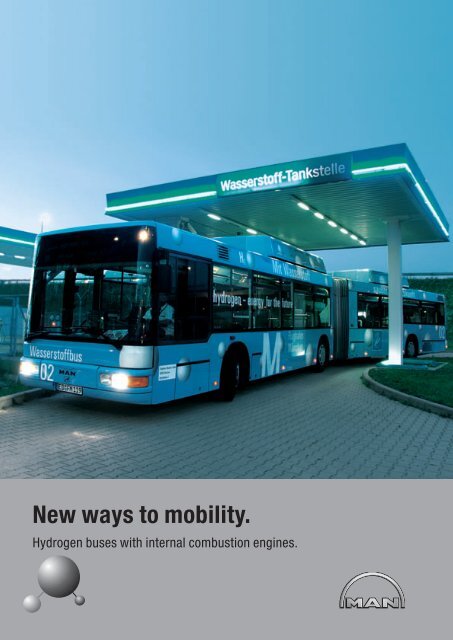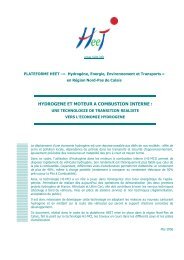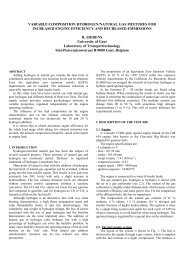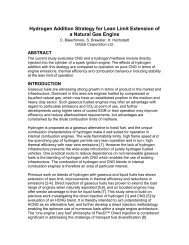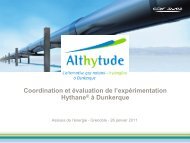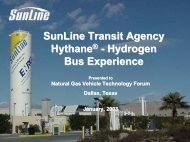Hydrogen - Althytude
Hydrogen - Althytude
Hydrogen - Althytude
Create successful ePaper yourself
Turn your PDF publications into a flip-book with our unique Google optimized e-Paper software.
New ways to mobility.<br />
<strong>Hydrogen</strong> buses with internal combustion engines.
<strong>Hydrogen</strong> –<br />
the fuel of the future<br />
<strong>Hydrogen</strong> – the oldest, lightest and most frequently found<br />
element in the universe is also the simplest chemical element.<br />
This small molecule could be the solution to a major problem –<br />
the dependence on fossil fuel and global warming caused by<br />
emissions of carbon dioxide. The substance with the molecular<br />
formula H2 can be produced from renewable resources, has<br />
no impact on the environment and in principle is available in<br />
infinite quantities. With these attributes hydrogen certainly<br />
fulfils the requirements of a fuel to ensure mobility in the future.<br />
MAN and Neoplan, with their great commitment to the development<br />
of buses with hydrogen drives, demonstrate that the<br />
H2 future is rapidly becoming reality.
Boundless energy.<br />
As a part of the biological cycle, hydrogen can be found in<br />
numerous organic compounds and it is a component of water.<br />
The fact that about 71 % of the surface of the earth consists<br />
of water just goes to show what an inexhaustible energy source<br />
hydrogen is. Today the most promising method of producing it<br />
is electrolysis, the splitting of water into hydrogen and oxygen<br />
with the aid of electricity. It makes good ecological sense to<br />
generate the energy necessary to achieve this from renewable<br />
sources such as the sun, wind or hydroelectric or geothermal<br />
power.<br />
NEOMAN Bus gases up.<br />
As a pioneer of gas drives the NEOMAN Bus Group puts its<br />
great expertise in this field to good effect in the systematic<br />
ongoing development of environmentally acceptable drive<br />
concepts. Today MAN is the leader in Europe in natural-gas<br />
buses with CNG and LPG engines and is the first manufacturer<br />
to offer a complete range of natural-gas low-floor buses. Back<br />
in 1996 MAN presented the first hydrogen bus with an internal<br />
combustion engine worldwide to the public and then carried out<br />
two years of trials of the hydrogen engine in customer service.<br />
By deploying this bus in regular service it was possible to give<br />
an impressive demonstration of the suitability of the hydrogen<br />
engine for day-to-day use. Spurred on by this success, the<br />
second generation of low-floor buses with hydrogen-fuelled<br />
internal combustion engines came onto the road in 1999.<br />
.
The hydrogen bus with internal combustion engine:<br />
en route towards series production.<br />
Experience leads the way.<br />
Since mid 1999 three low-floor articulated buses with hydrogen<br />
drives have been in service transporting passengers at Munich<br />
Airport – two MAN Lion’s City buses and a Neoplan Centroliner.<br />
Together they have already covered a distance of over 350,000<br />
km. At the end of the five-year project period of this joint venture,<br />
known as the ARGEMUC project, the partners will continue their<br />
collaboration. In April 2004 another MAN hydrogen bus started<br />
demonstration service for the BVG public transport company in<br />
Berlin. All these buses have hydrogen combustion engines.<br />
Parallel to this the NEOMAN Bus Group is also developing and<br />
evaluating the use of hydrogen in forward-looking fuel-cell drives.
The environmental engine of progress.<br />
The H 2876 UH hydrogen engine is a naturally aspirated<br />
6-cylinder in-line engine installed horizontally which operates<br />
according to the four-stroke Otto principle. The monovalent<br />
engine, i.e. designed exclusively for operation with hydrogen,<br />
with a capacity of 12.8 litres develops an output of 150 kW<br />
(204 hp) and a maximum torque of 760 Nm. A considerably<br />
more powerful engine with exhaust-gas supercharging and an<br />
output of 200 kW (272 hp) is expected to be ready for vehicle<br />
trials in 2006.<br />
The typical features of hydrogen engines are the external fuel<br />
preparation and the ignition by means of spark plugs. Since<br />
hydrogen ignites more easily and combusts more rapidly than<br />
petrol, measures must be taken to prevent spontaneous<br />
ignition, backfiring in the intake duct and knocking. MAN’s<br />
hydrogen engine therefore has a lower compression ratio of<br />
8.5 : 1, sequential multi-point hydrogen injection by means of<br />
electromagnetic valves and a map-controlled injection system<br />
with special spark plugs with platinum electrodes.<br />
A slightly oversaturated hydrogen/air mixture is ignited. A secondary<br />
catalyst minimises the nitrogen oxide emissions (NOx)<br />
by over 95 %. MAN’s hydrogen engine falls well within all the<br />
fixed future EU exhaust-gas limits through to Euro 5 and even<br />
achieves considerably better emission values than those laid<br />
down in today’s most demanding exhaust-gas standard, EEV<br />
(Enhanced Environmentally Friendly Vehicle).<br />
Exhaust emissions of the hydrogen engine<br />
H2866UH01<br />
5<br />
[g/kWh]<br />
5<br />
4<br />
3,5<br />
3<br />
2<br />
2,1<br />
1,5 1,5<br />
2<br />
Euro 3*<br />
Euro 4* (as of 2006)<br />
Euro 5** (as of 2009)<br />
<strong>Hydrogen</strong><br />
1<br />
0<br />
0,66 0,46 0,46<br />
0,4<br />
0,04 0<br />
0,1<br />
0,02 0,02 0,02<br />
HC CO NOx PM<br />
*ESC 13-stage test for diesel engines (including diesel<br />
engines with oxidising catalytic converter)<br />
**ESC 13-stage test
<strong>Hydrogen</strong> on board.<br />
Unlike electrical energy, hydrogen can be stored in large quantities.<br />
There are two alternative methods: One is the storage of<br />
liquid hydrogen at minus 253°C. A high energy density can be<br />
achieved in this way, but it requires more elaborate thermal<br />
insulation.<br />
The other method – the one used by MAN and Neoplan - is the<br />
storage of gaseous hydrogen in pressurised tanks at a pressure<br />
of 350 bar. On buses there is enough room on the roof for a storage<br />
system which gives them a wide enough operating range.<br />
Depending on the task of the vehicle an operating range of<br />
150 – 250 km can be assured.<br />
Filling up made easy.<br />
Filling up with gaseous hydrogen is as easy as with diesel fuel.<br />
The main difference is the pressure-tight, low-temperature<br />
resistant coupling instead of a fuel nozzle. To fill the vehicle up<br />
the coupling is attached to the tank neck and locked in place<br />
with a lever; then the hydrogen can flow. It takes just 10 minutes<br />
to fill a bus up manually. By the way, if necessary the compressed<br />
hydrogen can be produced from liquid hydrogen.
Looking ahead.<br />
<strong>Hydrogen</strong> has a future. We at MAN and Neoplan are working<br />
hard to continue development of the environmentally friendly<br />
technology of hydrogen drives and to make it ready for series<br />
production. We have successfully demonstrated just how<br />
serviceable this fuel is for buses. We are convinced that hydrogen<br />
will permit us to open up a new era in local passenger<br />
transport. Now it is our task to pave the way and inspire the<br />
general public with enthusiasm for this fascinating form of<br />
lasting mobility.
NEOMAN Bus GmbH<br />
Heinrich-Büssing-Straße 1<br />
D-38239 Salzgitter<br />
www.neoman.de<br />
A member of the MAN Group<br />
D112.432/E · mu 05052 · Printed in Germany<br />
Text and diagrams non-binding.<br />
Subject to alteration in course of technical progress.


